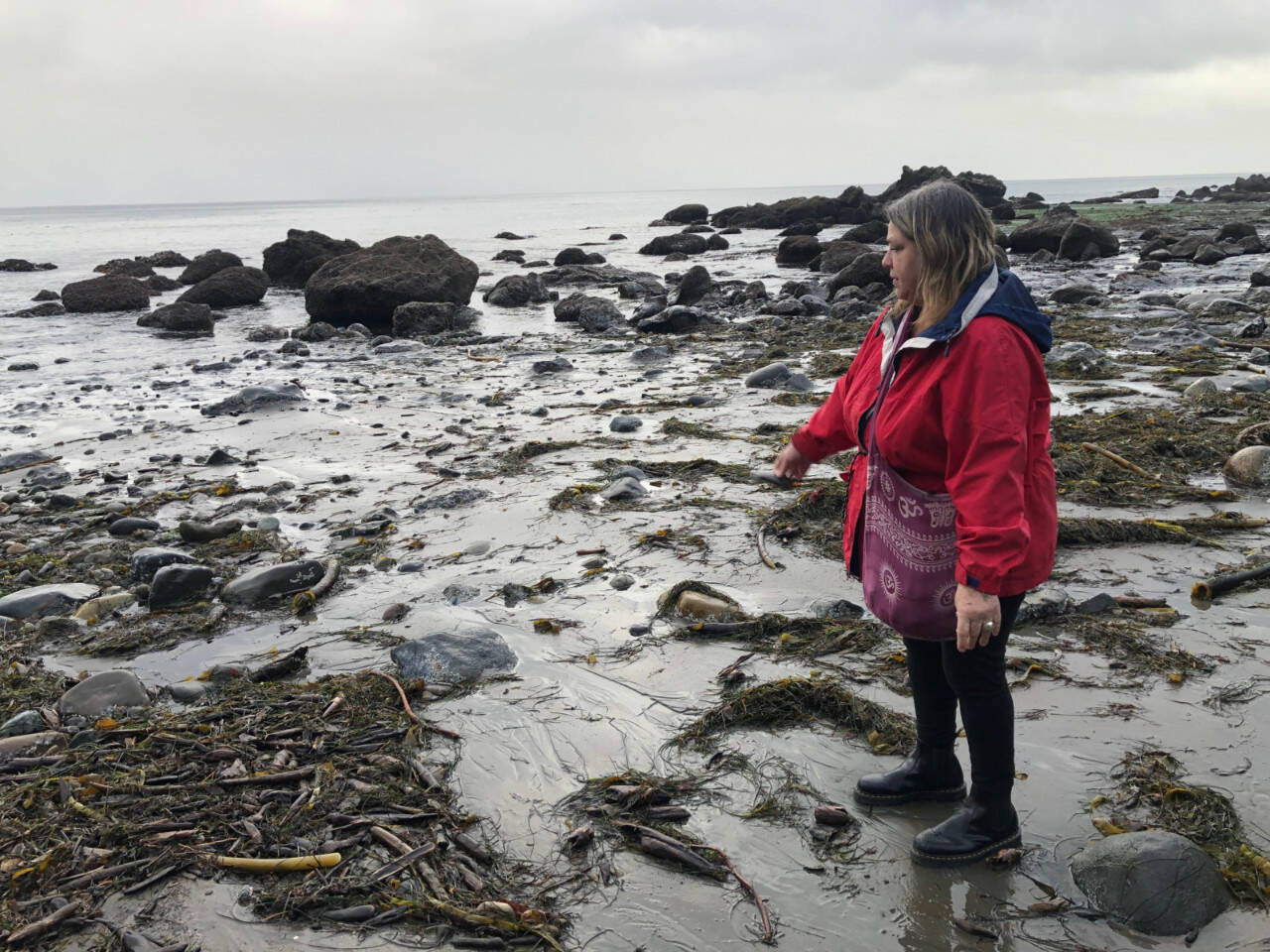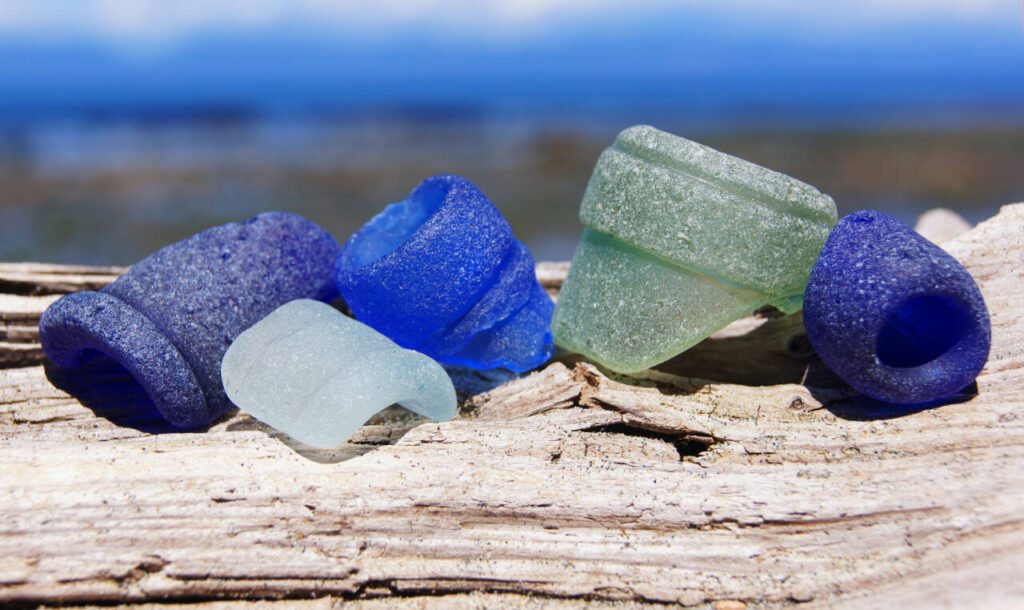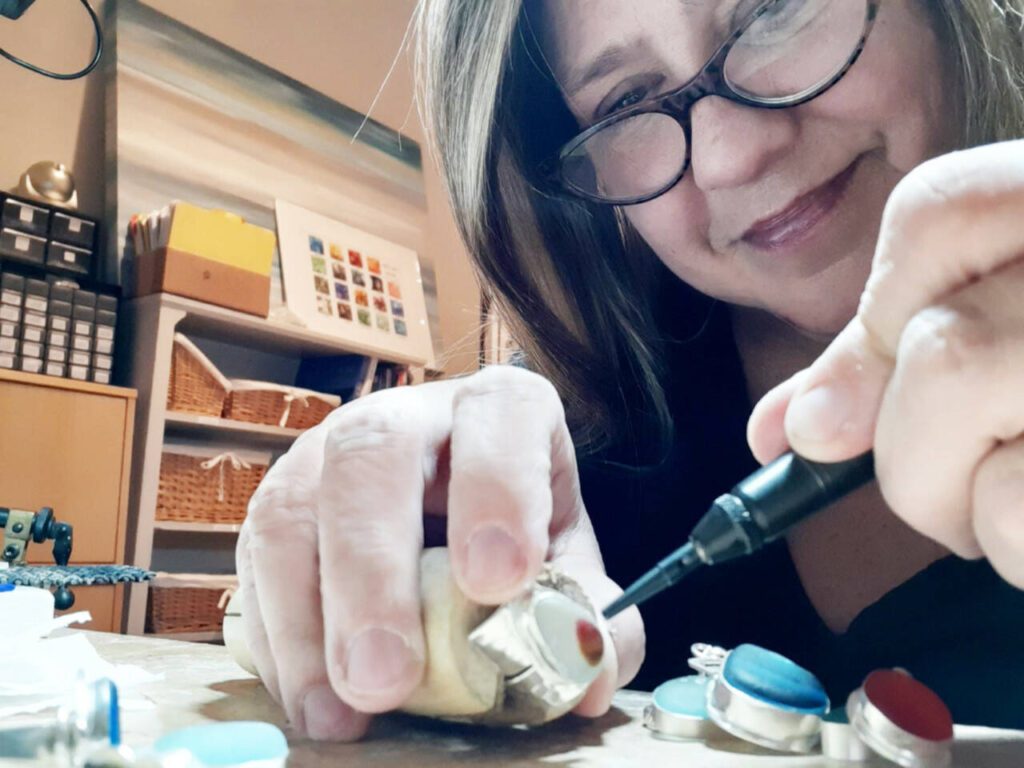Some believe they are mermaids — half woman, half fish — fairies of the sea.
The Greek god Neptune, the controller of winds and storms, ruled the sea in tales of old. Mermaids were his maidens. If a mermaid, known for promiscuous dalliances, fell in love with a pirate, sea captain or sailor, jealous Neptune would banish the mermaid into the depths of the seas.
Her tears, borne out of a broken and pining heart, would crystalize and wash ashore as sea glass. The hardened tears, the color of the mermaid’s eyes, would find their way into her lover’s fustian pockets or leather knapsack.
Sometimes, in real life, from points across the oceans, mermaids call Mary Beth Beuke, considered an expert in beachcombing for sea glass up and down the Pacific Coast, from Mexico to Kodiak, Alaska.
“People will call, and ask, ‘Are you guys mermaids?’” she said.
She is not a mermaid.
Mary Beth is the author of the coffee table book, “The Ultimate Guide to Sea Glass: Finding, Collecting, Identifying, and Using the Ocean’s Most Beautiful Stones,” and also the owner and artist of West Coast Sea Glass, based in Sequim, where she turns sea glass into jewelry.
She is in demand, even from mermaids.
For Mary Beth, sea glass is more of a science and a passion, than mermaid folklore. But Mary Beth is a kind soul, ready for a tall tale and an in-the-know titter. Away from mermaids’ calling and Neptune’s envy, Mary Beth knows where to find sea glass and how to sleuth sea glass origins.
The Daily World met up with her on a stormy, blustery late winter day along the Washington coast, where the Strait of Juan de Fuca gathers with the Pacific Ocean. Weather reports that day called for winds between 30 and 40 miles per hour, with gusts up to 50 miles per hour, and predictions of trees blowing down and blocking roads, of widespread power outages.
The National Weather Service stated, “Travel will be difficult.” When asked if it was appropriate to cancel the meeting, Mary Beth said it would be an adventure.
Ideal sea glass conditions
She was waiting on a dirt roadside pull-off in her tiny, hip, light-avocado green Fiat, one later she would drive with purpose and glee at inappropriate speeds.
At the beach, the rain and wind held off and a warm gray mist took over. The small shore was tucked away off a main road where it curves around the rugged coastline, under a small bridge, and easily accessible. Mary Beth made The Daily World promise to not reveal the site.
“If you tell the site, it will be overrun the next day,” she said.
Mary Beth chose the beach for its promise of sea glass. First, it was remote, and not picked over. A freshwater stream gently flowed from the hills, under the bridge, and into the Straits.
An old community long gone, was upstream, with residents likely throwing away glass bottles — from the light green-blue familiar Coke bottle to the dark blue sea glass that comes from old medicine bottles.
“Humans always gravitate to a freshwater source,” Mary Beth said while walking along the beach. Two eagles cried overhead. “A hundred years ago they would discard their garbage into the river.”
Brown, aqua and clear glass were scattered about as well, found among the pebbles strewn about the beach, above the tide line, but below where larger rocks and boulders, driftwood and uprooted trees were blown ashore.
“You go through the patches of cobble and tiny rocks, you go all the way to the lowest tide,” she said. “You go where the tide is going out. Most sea glass is down where the pebbles are, the tide will drop it off.”
Most of the glass was small, the size of a dime or less. She said the aqua color of bell-shaped electronic insulators are a good find after being smoothed by the sea. She said surf-worn marbles are the Holy Grail.
Mary Beth said sea glass, with the decline of glass used for everything from car headlights to bottles, has been overtaken by plastic, but that is another story.
“The sea glass window is closing,” she said. “Pieces are getting smaller, getting tumbled and tumbled.”
Mary Beth does find glass; she also enjoys time outside, on the saltwater. Along the creek, she finds a shard of pottery. She estimates it is Fiesta from the 1940s, likely used as a soup bowl.
“This is the real deal, and it is in the natural environment,” she said.
Mary Beth grew up on the Oregon coast, at a time when youngsters could just wander about. She chose to walk the beaches as a child. Later, she would move to Sequim, where she lived on the water and raised her three kids. The Olympic Peninsula, with its mountains and the ocean, is where she is centered.
“I like that I can go to a different world in a half day, and I can travel to my heart’s content and be among the beauty,” Mary Beth said. “The Olympic Peninsula — you get the forests, mountains, rivers, beaches. I’ve probably been to a thousand beaches.”
Mary Beth lives her life around tide charts and barometric pressure readings, from sunrise to sunset.
“The best time to go is at high tide as it goes down,” she said. “After the high tide is receding, all the way to low tide. I like going early before it gets populated, mainly I like the solitude.”
Tips on finding sea glass
Freshwater flowing into the sea is a start.
“Overcast days are good because on sunny days, it casts a lot of shadows on the beaches, sea glass will hide in the shadow,” Mary Beth said, adding she does like the warm sunshine, and chose to live in Sequim because it is situated in a rain shadow.
While Mary Beth enjoys a sunny day on the beach, she does not bring along a bikini, sexy sunglasses or sunscreen cream.
“All of those things are not my things,” she said.
Instead, she dons hiking boots, on this particular day black leather Doc Martens. She also brings along a book to read and layers of clothing. Not much more.
“I’m a minimalist,” she said.
Mary Beth’s talents
She is a silversmith, using torches and rotary motor drills powered by hand to craft sea glass into jewelry. She said many people send her sea glass they have found, and have her create unique jewelry that could be a future family heirloom.
She earned a college degree in graphics reproduction and photography. She taught photo lab work at the college level, winning two national photography competitions, and currently teaches the melding of small businesses and art at Peninsula College in Port Angeles.
Mary Beth is one of the founding members of the Sea Glass Association. She has been the keynote speaker at the International Beachcomber’s Conferences in Hawaii. She’s judged the North American Sea Glass Festival’s Shard of the Year contests. Her work has been published in National Geographic, Smithsonian, the New York Times, Seattle Times, Coastal Living and others.
In March, in Ocean Shores, she was the featured lecturer at the Coastal Interpretive Center as part of its 2022-23 Glimpses Lecture Series, titled, “The Sea Glass Adventure: History, Archaeology, and Wild Rarities.”
Sleuthing sea glass history
She looks with disdain at those who use tumblers and polishers to get the authentic look of sea glass. There’s no fun, no adventure in that. She looks at found sea glass for clues, from the curvature indicating a bottle or container, to the color, blue for example, indicating a poison bottle of old.
She pulls out an ultraviolet flashlight and shines it on some sea glass she brought along. It lights up. The glow reveals the ingredients that went into the glass; if uranium was used to create a certain color, it glows.
“A lot can reveal the glass recipe and when the vessel was first manufactured, color is one of the first identifiers. Coca-Cola produced their seafoam green color, and all factories used them after 1916 when the process was patented,” she said.
Sea glass from buttons reveal their origins from the fastening marks to their colors. She produced a sea-worn button from her pocket, stating the color and markings make it likely pre-1950s.
“The value of sea glass is the journey, where the piece has been and the history of it,” Mary Beth said. “Defining the history of a piece is a little bit of a challenge between true history and one’s imagination. It’s fun to think that some tipsy pirate threw his rum bottle off a schooner, and the piece washed up a hundred years later. It’s kind of exciting to look at a piece and wonder how many miles it’s traveled and whose kitchen it came from, what olive oil bottle it may have originated from.”
Talk to us
> Give us your news tips.
> Send us a letter to the editor.
> More Herald contact information.



























